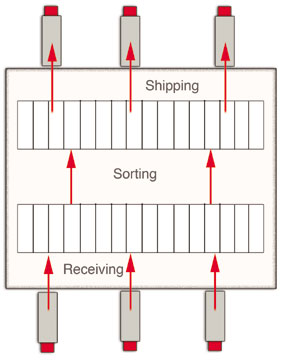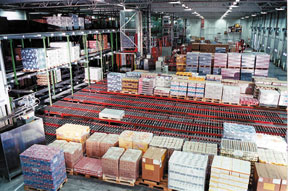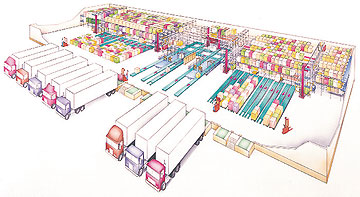Cross Docking: Is it right for me?
This article is the first in a series of articles on the subject of cross docking.
 Judging by the number of inquiries we receive relative to inventory management in distribution, a look at cross docking practices seems to make sense. This will be the first of a series of briefs on cross docking, how and where it works, and a look at some best practice ideas that might be useful to those of you in the distribution business (of all sizes). I’ll also be providing you links to some excellent online references for more information.
Judging by the number of inquiries we receive relative to inventory management in distribution, a look at cross docking practices seems to make sense. This will be the first of a series of briefs on cross docking, how and where it works, and a look at some best practice ideas that might be useful to those of you in the distribution business (of all sizes). I’ll also be providing you links to some excellent online references for more information.
Most everyone is familiar with how those like Wal-Mart took the cross docking model, and essentially redefined supply chain efficiency. The results achieved are well-documented. For those of us involved with mid-size organizations, a compelling case can be made for considering cross dock principles in our distribution centers. If you are able to move material from receiving dock to shipping dock, and bypass storage, consider what you gain. Costs associated with holding inventory, protecting it, insuring it, picking it, counting it, and so forth.
Although the “cross docking” term is well ingrained in our supply chain lingo, it is important to understand the concept also applies elsewhere in our distribution centers (more on that later), notwithstanding what you call it. Let’s begin.
Inventory is the Real Issue
We all deal with a variety of costs in our supply chains. At the top of your list and my list are order-picking costs and inventory holding costs. Your goal is to minimize or eliminate both. In addition, freight cost reductions can also represent significant potential, particularly for those dealing with LTL’s and small package carriers. Most of you, who get this right, are using tools to better manage information, and to better manage or coordinate with your supplier chain partners. It is not necessary to be large in size to take advantage of a cross dock model. Many of today’s solutions are both modular and scalable. These tools allow you, the distributor, to better consolidate your shipments and shorten your cycle time.
Most of you deal with products from multiple vendors which enter your distribution centers. These products are typically not ready for direct transfer to your shipping docks. As a result, you must create a label for the product upon receipt, and then move the product to the correct shipping area. This increases costs because a non-value add touch point(s) is required. Essentially, the question is who does the work to prepare the product for shipment. We both would rather the vendor handle it, but that is not always reality. In our case, we scan the incoming shipment, a lookup is performed, and a new label is created and applied to the product, readying it for shipment. This approach is known by various names, one of which is “post-distribution”. If you negotiate with your vendors to label products that can be cross-docked directly to your shipping area, then you will see terms like, “transshipment ready”, “transload ready”(an incorrect usage), or “pre-distribution”.
When does cross docking begin to make sense? Begin with considering the order profiles of your key customers. Like us, you may have many customers who tend to order the same products in significant volumes throughout the year, or at least seasonally. In effect, supply and demand are pretty much predictable, allowing you to match each with the other. Begin with these products as candidates. Some products will be filtered out of this mix. For instance, those that require excessive handling in order to move, or products of an unusual shape, size, or excessive weight would be examples. Also, products that are FIFO, or date-sensitive make poor candidates.
When you engage in a supply chain enhancement such as cross docking, the players both upstream and downstream of you play key roles. In fact, they will define your success or failure. Our experience is that all can benefit when all are involved. Otherwise, you may simply be going through an exercise in which some costs are passed off to another link in the supply chain.
In upcoming briefs, we will look at the following areas. You are welcome to comment below with any questions or comments.
- Am I wasting my time……is this a viable consideration for my company?
- Cross dock layout alternatives that work
- Getting started……understanding a simple system (and costs)
Am I wasting time: is cross-docking a viable consideration for my company?

This article is the second in a series of articles on cross docking
In concept and on paper cross docking looks great, but, what about actual implementation? What kind of return do we get on this investment? The short answer is the implementation can be challenging. However, with planning, a committed team of upstream and downstream participants, and possibly even a pilot program, it can pay significant benefits.
Cross docking does not have to be complicated. Some, even today, execute cross-docking using human-readable paper documentation as the driver. As mentioned in the original brief, cross docking can cover a wide range of distribution activities. In one door and directly out the other is one approach. Many cross dockers also add value in the brief (hopefully) interval between receiving and shipping. Others send product to a temporary buffer in the interval, in many of these cases an automated system (mini-load, AS/RS, etc.) serves as the buffer.
What might we potentially expect from a successful implementation?
- Reduction in capital investment in facilities and equipment (less space required)
- Reduction in inventory
- Reduction in personnel requirements
- Reduction in order cycle time
- Reduction in product damage (reduced touches)
- Reduction in freight costs
What are the gotchas, why we might fail?
- Facility layout is poor
- Internal information systems are not integrated
- Little or no integration and collaboration within your supply chain
- Compliance by all supply chain partners
- Selected the wrong products
- Reliable suppliers (accurate, on time deliveries)
- Sufficient volume of activity
- Understanding peak workload variations
Information will make you or break you
To best manage your inventory, you really need visibility into what you will be receiving, before receiving it. Advance Shipping Notices (ASN) are what provide this visibility.
Most of you are familiar with these, and probably already use them in some form. With ASN’s, you know what is arriving and when. With your Warehouse Management System (WMS) you know what is in your warehouse. Marry these with your order management system and you have the information necessary to match current inventory with order requirements, and get orders out the door efficiently (transportation covered shortly) You begin to see the need for cooperation and communication across the supply chain. The value (necessity) of EDI or internet connectivity becomes apparent. A level of information infrastructure is a must.
Supply chain partners are just that, partners in an integrated cross dock process. Select those that deliver products frequently, and deliver them on time. Most of you already have a solid handle on who are possible vendor partners, those with whom you are currently highly collaborative. Those whose products require a very limited number of touch points in the cross dock, if any touch points at all.
Touch points are work. Who does the work?
As a distributor or cross docker, identifying who “preps the products” for shipment is a fundamental consideration. For instance, incoming products were pre-labeled by the vendor for outgoing shipment (they did the work). Alternatively, the incoming products require labeling on your dock prior to outgoing shipment (you do the work). A third case might be the incoming products have been pre-labeled, but might need something additional, such as de-palletizing before outgoing shipment (we both do some work). A good answer to, “Who does what?” is “Who can do it most efficiently in the supply chain?”
Organizations that are process-driven, with a continuous process improvement mentality fit well in a cross dock environment. They tend to establish metrics, measure, and effectively use feedback for improvement. Those achieving high levels of efficiency will track and trace products throughout the entire supply chain to capture data which drives these improvements. Ongoing emphasis on training and education plays a key role.
In our next brief, we will touch on transportation, and then move into facility layout alternatives, what works, what does not, and links to a couple of good case studies and online tools. You are welcome to e-mail me with any questions or comments.
Upcoming briefs:
- Cross dock layout alternatives that work
- Getting started understanding a simple system (and costs)
Resources for additional information on cross docking. Both are worth a look.
- Warehousing and Education Research Council’s (www.werc.org) guide to cross docking: Making the Move to Cross Docking
- Kevin Gue, Professor, Graduate School of Business and Public Policy, Naval Postgraduate School, numerous articles, research, and tools with a focus on cross docking (http://www.scivis.nps.navy.mil/~krgue/index.html)
Cross Docking: What are the facility layout considerations?
This is the third in a series of articles on cross docking

If you started from scratch, many might simply build a cross dock facility with a much shallower depth than most warehouses. A depth of a hundred feet or so, with incoming product on one side that can be easily moved a short distance and loaded on the other side to an outbound truck. Most of us however, must deal with an existing facility, many times a large square box which is not generally the preferred layout. However, as long as the existing facility has a sufficient quantity of dock doors, yard space, and an adequate footprint, you may be fine…
Simply having a lot of dock doors does little for efficiency if the doors are located on opposite walls at a great distance from one another. Conveyor companies might love this, but there are better alternatives. Some recommend all the doors on one wall, or even at 90 degrees to one another. High speed movers would then travel between incoming and outgoing doors in closest proximity to one another. Proximity of high traffic incoming and outgoing doors is key. Distance equals costs. Many consider dedicating only a portion of their facility for cross dock duties as an acceptable workaround.
Pallet handling versus case handling create separate requirements. Congestion in dock areas will be a killer. Sufficient dock space is key to moving products quickly and safely. This is particularly true if the company is growing or deals with seasonal products. Ample space must be available for any pallet staging activities near shipping doors. If aisles are part of your logical pathways, then oversize them in high traffic areas.
One of the more complete reviews of cross dock design is by John Bartholdi and Kevin Gue in Transportation Science. They provide an analysis of the impact of “shape” on the performance of a cross dock operation. They considered a wide variety of designs and freight flow patterns, and offered the following summary:
“Shape matters. Freight must be moved across the dock and total distance traveled is a good estimate of labor costs. The best shape for small to mid-sized cross docks is a narrow rectangle or I-shape, which gets maximum use of its most central doors. For larger docks, alternative shapes are more attractive. The best shapes for larger docks will have piers branching out from a central area. These designs have more corners, for which they pay a cost. However, they achieve greater centrality, and so more distant doors are closer to other doors. For example, the T-shape is best for dock sizes between about 150 to 200 doors. For larger than 200 doors, the X-shape is best. Despite having four inside corners near the center of the dock, the worst doors are not far from the center. When freight flows are concentrated among few destinations, the point will be deferred at which a more complicated design becomes attractive. This is because the labor will be concentrated on a subset of the dock, and so the dock is, in effect, a smaller dock.”
Layouts designed on solid principles will address the “layout issue”. Although we have been focusing on the internal logistics of cross docking, we do need to make note of another obvious area of interest…. the “trailer spotting” issue. A poor spotting process defeats a quality layout. They work in concert. There are many issues you deal with in creating an optimum design for cross docking. In the next brief, we will take a look at cross docking in actual practice. This will include a couple of applications that deal with the issues we have discussed, and others. One application is complex, the other is a simple scalable system (actually including system costs).
Cross Docking: A retailer improves supply chain
This is the fourth in a series of briefs on cross docking
A recent project for a large retailer in the Southwest provided a good example of how an element of cross-docking might be deployed to reduce the footprint of distribution space required, reduce order fulfillment touchpoints, and shorten the logical pathway for fulfilling orders.
Incoming shipments are anticipated through the use of advanced shipping notices (ASN’s). Stretch-wrapped pallet loads arrive via truck throughout the day. They arrive at doors designated for cross-docking. These doors were selected based upon proximity to the material handling system which takes advantage of the facility layout. Pallets are unloaded by fork truck, the stretch wrap removed, and cases manually inducted into one of several conveyor staging lanes. Each lane represents a “wave” of orders which will be processed either that day, or a specific day later in the week. When a wave is released, it moves downstream, and the individual cases are sorted to a specific shipping lane whose products are destined for a particular store. Other products from static storage positions and non-conveyables destined for the same store are consolidated at this point.
As waves are released, the staging lane becomes immediately available for a subsequent wave. Multiple waves are processed daily. Pallets arrive at the receiving docks with man-readable labels indicating the destination store and day to ship. The individual cases on each pallet are pre-labeled (pre-distribution) with a unique identifier that corresponds to the ultimate destination retail store, the SKU number, and the quantity. When the case label is scanned for the identifier, a lookup into a warehouse control system database occurs, which provides the routing instructions, ie, the correct shipping door. Again, orders can be comprised of cases that are cross-docked from the staging lanes, product stored in static storage positions, and/or non-conveyables. The sortation management system routes all conveyables in the current wave directly to the correct shipping lane.
Order fulfillment occurs in waves, due to a limited number of shipping doors. Most shipping doors are dedicated to a specific destination store, while a handful of other doors will each serve a number of smaller retail stores. This distribution center demonstrates how cross-docking products that are good candidates, can be integrated with order fulfillment of inventoried products to enhance overall distribution performance.
Next month we will look at a scalable, “out-of-the-box” cross docking system, its layout, and cost to purchase and implement. It will include conveyors, controls, and software to support a basic cross docking system. We have taken a modular approach to a systems solution that can truly be modularized. Join us.







